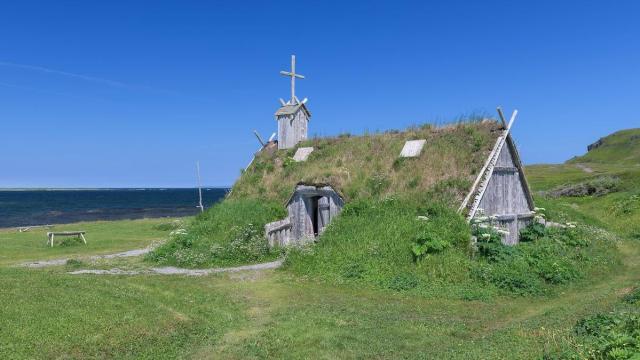Vikings were active at a Newfoundland settlement nearly 500 years before Christopher Columbus crossed the Atlantic, research suggests.
On the northernmost tip of the northernmost peninsula of Newfoundland, Canada, is a prehistoric Viking settlement known as L’Anse aux Meadows. The site has been explored by archaeologists since the 1960s, but a firm date for the settlement has proven elusive.
Research published in Nature adds some much-needed clarity to the issue. A team led by archaeologist Michael Dee from the University of Groningen in The Netherlands provides new evidence showing that Vikings were active at L’Anse aux Meadows by 1021 CE — exactly 1,000 years ago. In an email to Gizmodo, Dee said his team’s findings represent the “first, and only, known date for Europeans in the Americas before Columbus,” who crossed the Atlantic in 1492 CE.
That Vikings were capable mariners is no secret. Norse settlers are believed to have reached Iceland by the late 9th century and North America by the 11th century, though the exact timing of the latter event has remained a matter of debate. I asked Dee why it took so long for archaeologists to date the site.
“Well, in order to date archaeological sites one needs either contemporary written records or a considerable number of artifacts that can be placed within a certain time range,” he replied. “L’anse aux Meadows did not yield either of these things. The best scientific dating method is probably radiocarbon dating but it tends only to be able to provide dates to the nearest few centuries,” said Dee, who added that the method used in the current study only became available in the last few years.

To date the site, Dee and his colleagues analysed three pieces of wood gathered from the site, all of which came from different trees. These pieces of wood were leftovers from the chopping of wood and associated with Viking activity at L’anse aux Meadows; the distinctive chips showed signs of cutting and slicing and were clearly produced by metal tools, which the indigenous people living in the area at the time were not known to possess.
The team then used distinctive features of the atmospheric carbon record to constrain the radiocarbon dating of the felled trees. The incredible degree of dating precision was made possible on account of a massive solar storm that occurred in 993 CE, which left a distinct radiocarbon signature in tree rings around the world.
Trees suck up carbon from the atmosphere and channel it into their annual growth rings. A spike in the concentration of radiocarbon growth rings was recently found to correspond to the solar storm.
“By measuring the radiocarbon concentration of the tree rings in the Viking wood, we were able to find this same spike,” said Dee, which meant that the ring originated in 993 CE. From there, “it was just a case of counting the rings to the bark edge to work out when the last ring was laid down,” that is, when the tree was chopped down, he explained. The researchers applied this technique to all three pieces of wood, with all of the results returning a cutting date of 1021 CE.

“Our new date lays down a marker for European [awareness] of the Americas, and represents the first known point at which humans encircled the globe,” wrote the scientists in their study. Accordingly, the new research carries implications for the future study of early transatlantic activities, such as the potential exchange of genetic material between Vikings and indigenous people, the introduction of new plant or animal species, and the spread of diseases.
Vikings were present in North America by 1021 CE, but many questions still remain. The total number of excursions to the continent are not known, nor is the total duration of their stay. That said, it doesn’t appear that the Norse spent too much time in North America.
“They were probably there looking for timber, and other resources, to take back to Greenland,” Dee explained. “There were maybe 100 Norse people at the site. We know from some plant remains found at the site that they also ventured further south in the Americas, but we don’t exactly know where. From the amount of rubbish left and because no Norse burials have been found, most archaeologists think they were at L’Anse aux Meadows for quite a short time.”
Looking ahead to future research, Dee hopes that archaeologists might find the remains of more exotic plants, which could point to other North American locations explored by the Norse. Regardless, the new research attests to the Vikings’ remarkable accomplishments and extensive global reach.
This article has been updated since it was first published.
